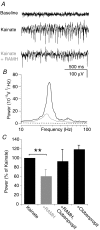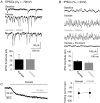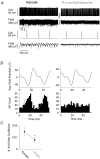Histamine H3 receptor activation decreases kainate-induced hippocampal gamma oscillations in vitro by action potential desynchronization in pyramidal neurons
- PMID: 20156850
- PMCID: PMC2872730
- DOI: 10.1113/jphysiol.2009.180984
Histamine H3 receptor activation decreases kainate-induced hippocampal gamma oscillations in vitro by action potential desynchronization in pyramidal neurons
Abstract
The study of rhythmic electrical activity in slice preparations has generated important insights into neural network function. While the synaptic mechanisms involved in the generation of in vitro network oscillations have been studied widely, little is known about the modulatory influence exerted on rhythmic activity in neuronal networks by neuropeptides and biogenic amines. Gamma oscillations play an important role in cognitive processes and are altered or disrupted in disorders such as Alzheimer's disease (AD) and schizophrenia. Given the importance of gamma oscillations for learning, memory and cognition processes as well as the recent interest in histamine H(3) receptors in the development of pro-cognitive drugs to treat disorders such as AD and schizophrenia, it is relevant to study the impact of histaminergic mechanisms on network gamma oscillations. Here we show for the first time a modulation of gamma oscillation by histaminergic mechanisms. Selective activation of the H(3) receptor by R-alpha-methylhistamine significantly reduces the power of kainate-induced gamma oscillations, but not carbachol-induced gamma oscillations, in the rat hippocampal slice preparation without affecting oscillation frequency. This effect is neither caused by a decrease in excitatory or inhibitory postsynaptic currents, nor a decrease in cellular excitability. Instead, we find that the decrease in oscillation power following H(3) receptor activation results from a desynchronization of pyramidal neuron action potential firing with regard to the local field potential oscillation cycle. Our data provide a possible mechanism of action for histamine in regulating gamma oscillations in the hippocampal network.
Figures



References
-
- Castillo PE, Malenka RC, Nicoll RA. Kainate receptors mediate a slow postsynaptic current in hippocampal CA3 neurons. Nature. 1997;388:182–186. - PubMed
-
- Dickinson R, Awaiz S, Whittington MA, Lieb WR, Franks NP. The effects of general anaesthetics on carbachol-evoked gamma oscillations in the rat hippocampus in vitro. Neuropharmacology. 2003;44:864–872. - PubMed
-
- Drutel G, Peitsaro N, Karlstedt K, Wieland K, Smit MJ, Timmerman H, Panula P, Leurs R. Identification of rat H3 receptor isoforms with different brain expression and signalling properties. Mol Pharmacol. 2001;59:1–8. - PubMed
Publication types
MeSH terms
Substances
LinkOut - more resources
Full Text Sources

